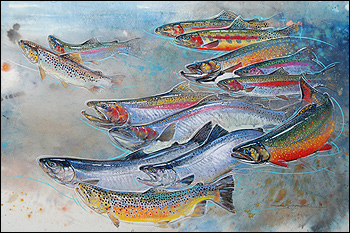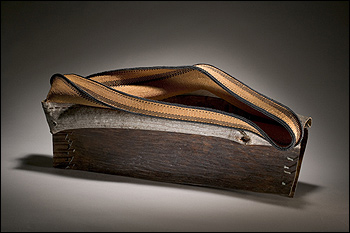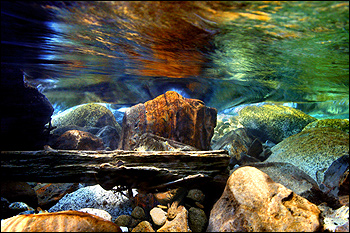
Let the Rivers Run
McKenzie River Trust show at the Jacobs Gallery
By Suzi Steffen
If Eugene’s gloomiest doomsayers were right and peak oil caught us unaware, our concrete highways might become large pedestrian spaces, but our rivers would return to their central status, providing us both water and vital transportation. In the meantime, rivers serve as metaphors, spaces for renewal and reminders that ecosystems contain more than office workers usually get to see. Oh, and they’re fantastic places for watercolor and other plein air workers; and in Oregon, their fish inspire sculptors as well.
 |
| Living River I, by Dan Chen |
 |
| Lush, by Sally Metcalf |
 |
| Inside The River, by Mary Edwards |
The many artists included in the Jacobs Gallery’s “The Living River: A Juried Art Exhibit” perfectly illustrate human reaction to the complexities and fascinations of riparian worlds. Surprisingly and disappointingly, few of the pieces in the show go beyond literal representation, and many of the watercolors and oils inevitably blend into a swirl of celebration of trees, birds, fish and water. But several of the many photographers in the show find ways to highlight amusing, poignant or breathtaking moments, and the sculptors and fiber artists also tend to push beyond the purely visual to a layered reflection on the waterways of Oregon.
The McKenzie River Trust (www.mckenzieriver.org) sponsored the exhibit, and a variety of river-related events occur throughout the month of the show. Jurors for the exhibit were Dottie Chase and Beverly Soasey and art historian David Turner; they picked Dan Chen’s pastel Living River I for first prize. Chen’s accomplished hand gives a sense of the salmon fighting their way through a muscling crowd of glorious fish. I think salmon faces are quite ugly, but Chen and other artists in the show, including Judith Sparks with Salmon Totem, give the fish dignity and the weight of responsibility for sustaining life in the Pacific Northwest. They remind me of the Columbia River show at the Portland Art Museum in the fall of 2008 (“Wild Beauty”). That exhibit showed film of the salmon run and also of Celillo Falls before and after it was submerged by the Dalles Dam. Salmon have served for centuries as part of an abundant and relatively easy life in the Pacific Northwest, but of course dams have made their runs smaller and smaller even as the country’s appetite for salmon has grown. So we need reminders like Chen’s piece that the salmon exist for themselves as part of the river’s ecosystem, a special kind of fish that lives in both fresh and salt water and struggles mightily to pass the river on to another generation.
Oregon’s blessed with a number of different and stunning locations whose natural beauty makes a photograph almost an insult — Crater Lake, Mount Hood, the lava formations, the Sisters … and, of course, spots along the McKenzie, Willamette, Columbia, Umpqua, Rogue and a gazillion other rivers. Most of the photographers in “Living River” found some way to give their pieces a slight distance, knowing that they can’t capture the experience in an exact replica.
For instance, Bob Sanov’s velvety, black-and-white gelatin print Cascades gives a lush, textural feel to the image, moving it beyond a window into the world and making it more like an abstract painting that reminds viewers of its art. I was not surprised to read in Sanov’s artist statement that he “especially love[s] the element of non-reality inherent in the black and white image.” Bingo. The river’s not like Cascades, but the experience of the river might resemble the tumble and flow of the clearly not “real” piece. Rich Bergeman’s Along the Lower Columbia adds a touch of nostalgia and mystery with its decaying moorings and broad expanse. Too much nostalgia destroys a landscape, but this piece is balanced with others in the show that celebrate the swirl and current of today’s life along the rivers.
Sally Metcalf’s woven works, like second-place winner Lush, use items from near the river as material. Her work thus becomes both literal — the living river! — and referential, abstract and wonderfully present. Sarah Grew doesn’t shy away from the abstract in her work either. Spinning uses camas lilies in a white acrylic emulsion to evoke a feeling of suspension, of small things stitching a world together. The mixture of scientific and botanical precision with patterned and thickly layered canvas hints at the ways a river inserts itself into our bodies and our minds.
Good art about the natural world evokes a variety of associations, but rivers aren’t on the planet merely to be evocative for human brains and souls. As the McKenzie River Trust works to protect the physical riparian environments, this show and its associated events tell us to get out of the gallery and make our own artful, spiritual, physical and grounded associations with the rivers we should use, love, think about and preserve.
“Living River” runs through May 2 at the Jacobs Gallery under the Hult Center. Remaining events include a 7 pm Friday, April 23, lecture entitled “Kesey’s Living Rivers” and a 7 pm Wednesday, April 28, reading/discussion with author Kathleen Dean Moore. See http://wkly.ws/hk for more information.